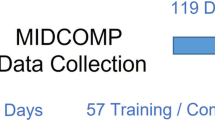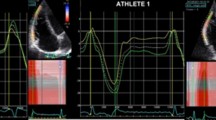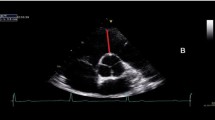Abstract
Cardiac adaptations to exercise on an elite level have been well studied. Strain analysis by speckle tracking echocardiography has emerged as a tool for sports cardiologists to assess the nature of hypertrophy in athletes’ hearts. In prior studies, strain values generally did not change in physiological adaptations to exercise but were reduced in pathological hypertrophy. However, research in this field has focused almost solely on male athletes. Purpose of the present study is to investigate strain values in the hearts of female elite athletes in football and volleyball. In this cross-sectional study echocardiography was performed on 19 female elite football-players, 16 female elite volleyball-players and 16 physically inactive controls. Conventional echocardiographic data was documented as well as left ventricular longitudinal, radial and circumferential strain values gained by speckle tracking echocardiography. The hearts of the female athletes had a thicker septal wall, a larger overall mass and larger atria than the hearts in the control group. Global longitudinal, radial and circumferential strain values did not differ between the athletes and controls or between sporting disciplines. No correlation between septal wall thickness and global strain values could be documented. Cardiac adaptations to elite level exercise in female volleyball and football players do not influence global strain values. This has been documented for male athletes of several disciplines. The present study adds to the very limited control-group comparisons of left ventricular strain values in elite female athletes. The findings indicate that global strain values can be used when assessing the cardiac health in female athletes.









Similar content being viewed by others
Data availability
The datasets generated and analyzed during the current study are not publicly available to protect the anonymity of the included individuals who-due to their sporting success- are figures of public interest; based on age, height, etc. conclusions regarding identities could be deduced for example by sports journalists. The data are available from the corresponding author on reasonable request. All data is stored for 10 years and contains the raw-data of all measurements described under methods.
References
Prior DL, La Gerche A (2012) The athlete’s heart. Heart 98(12):947–955. https://doi.org/10.1136/heartjnl-2011-301329
Pelliccia A, Adami PE (2017) The female side of the heart: sex differences in athlete’s heart∗. JACC: Cardiovasc Imaging 10(9):973–975. https://doi.org/10.1016/j.jcmg.2016.08.010
Richand V, Lafitte S, Reant P et al (2007) An ultrasound speckle tracking (two-dimensional strain) analysis of myocardial deformation in professional soccer players compared with healthy subjects and hypertrophic cardiomyopathy. Am J Cardiol 100(1):128–132. https://doi.org/10.1016/j.amjcard.2007.02.063
Butz T, van Buuren F, Mellwig KP et al (2011) Two-dimensional strain analysis of the global and regional myocardial function for the differentiation of pathologic and physiologic left ventricular hypertrophy: a study in athletes and in patients with hypertrophic cardiomyopathy. Int J Cardiovasc Imaging 27(1):91–100. https://doi.org/10.1007/s10554-010-9665-5
D’Ascenzi F, Caselli S, Solari M et al (2016) Novel echocardiographic techniques for the evaluation of athletes’ heart: a focus on speckle-tracking echocardiography. Eur J Prev Cardiol 23(4):437–446. https://doi.org/10.1177/2047487315586095
Pelliccia A, Caselli S, Sharma S et al (2018) European Association of Preventive Cardiology (EAPC) and European Association of Cardiovascular Imaging (EACVI) joint position statement: recommendations for the indication and interpretation of cardiovascular imaging in the evaluation of the athlete’s heart. Eur Heart J 39(21):1949–1969
Collier P, Phelan D, Klein A (2017) A test in context: myocardial strain measured by speckle-tracking echocardiography. J Am Coll Cardiol 69(8):1043–1056. https://doi.org/10.1016/j.jacc.2016.12.012
Beaumont A, Grace F, Richards J et al (2017) Left ventricular speckle tracking-derived cardiac strain and cardiac twist mechanics in athletes: a systematic review and meta-analysis of controlled studies. Sports Med 47(6):1145–1170. https://doi.org/10.1007/s40279-016-0644-4
Caselli S, Montesanti D, Autore C et al (2015) Patterns of left ventricular longitudinal strain and strain rate in olympic athletes. J Am Soc Echocardiogr 28(2):245–253. https://doi.org/10.1016/j.echo.2014.10.010
D’Ascenzi F, Pelliccia A, Alvino F et al (2015) Effects of training on LV strain in competitive athletes. Heart. https://doi.org/10.1136/heartjnl-2015-308189
D’Ascenzi F, Pelliccia A, Natali BM et al (2014) Morphological and functional adaptation of left and right atria induced by training in highly trained female athletes. Circ Cardiovasc Imaging 7(2):222–229. https://doi.org/10.1161/CIRCIMAGING.113.001345
Lang RM, Badano LP, Mor-Avi V et al (2015) Recommendations for cardiac chamber quantification by echocardiography in adults: an update from the American Society of Echocardiography and the European Association of Cardiovascular Imaging. Eur Heart J Cardiovasc Imaging 16(3):233–271. https://doi.org/10.1093/ehjci/jev014
Nagueh SF, Smiseth OA, Appleton CP et al (2016) Recommendations for the evaluation of left ventricular diastolic function by echocardiography: an update from the American Society of Echocardiography and the European Association of Cardiovascular Imaging. Eur Heart J Cardiovasc Imaging 17(12):1321–1360. https://doi.org/10.1093/ehjci/jew082
Voigt J-U, Cvijic M (2019) 2- and 3-Dimensional myocardial strain in cardiac health and disease. JACC: Cardiovasc Imaging 12(9):1849–1863. https://doi.org/10.1016/j.jcmg.2019.01.044
Butz T, van Buuren F, Mellwig KP et al (2010) Systolic and early diastolic left ventricular velocities assessed by tissue Doppler imaging in 100 top-level handball players. Eur J Cardiovasc Prev Rehabil 17(3):342–348
Cappelli F, Toncelli L, Cappelli B et al (2010) Adaptative or maladaptative hypertrophy, different spatial distribution of myocardial contraction. Clin Physiol Funct Imaging 30(1):6–12. https://doi.org/10.1111/j.1475-097X.2009.00896.x
Stefani L, Toncelli L, Di Tante V et al (2008) Supernormal functional reserve of apical segments in elite soccer players: an ultrasound speckle tracking handgrip stress study. Cardiovasc Ultrasound 6(1):14. https://doi.org/10.1186/1476-7120-6-14
Crouse SF, Rohack JJ, Jacobsen DJ (1992) Cardiac structure and function in women basketball athletes: seasonal variation and comparisons with nonathletic controls. Res Q Exerc Sport 63(4):393–401. https://doi.org/10.1080/02701367.1992.10608761
Engel DJ, Schwartz A, Homma S (2016) Athletic cardiac remodeling in US professional basketball players. JAMA Cardiol 1(1):80–87
Malmgren A, Dencker M, Stagmo M et al (2015) Cardiac dimensions and function in female handball players. J Sports Med Phys Fitness 55(4):320–328
Ünlü S, Duchenne J, Mirea O et al (2020) Impact of apical foreshortening on deformation measurements: a report from the EACVI-ASE strain standardization task force. Eur Heart J Cardiovasc Imaging. https://doi.org/10.1093/ehjci/jez189
Pelliccia A (1996) Athlete’s heart in women. JAMA 276(3):211. https://doi.org/10.1001/jama.1996.03540030045030
Finocchiaro G, Dhutia H, D’Silva A et al (2017) Effect of sex and sporting discipline on LV adaptation to exercise. JACC: Cardiovasc Imaging 10(9):965–972. https://doi.org/10.1016/j.jcmg.2016.08.011
Author information
Authors and Affiliations
Contributions
All authors contributed to the study conception and design. Material preparation and data collection were performed by JZ and IB, analysis was performed by JZ, IB, AS and EG. The first draft of the manuscript was written by JZ and all authors commented on previous versions of the manuscript.
Corresponding author
Ethics declarations
Conflict of interest
None of the authors have funding, competing interests or affiliations to disclose.
Ethical approval
All authors are committed to upholding the ethical standards required by the Journal. All procedures performed in studies involving human participants were in accordance with the ethical standards of the institutional research committee of the German Sport University Cologne, Germany, and with the 1964 Helsinki declaration and its later amendments or comparable ethical standards.
Informed consent
Informed consent was obtained from all individual participants included in the study.
Additional information
Publisher’s Note
Springer Nature remains neutral with regard to jurisdictional claims in published maps and institutional affiliations.
Rights and permissions
About this article
Cite this article
Zacher, J., Blome, I., Schenk, A. et al. Cardiac adaptations in elite female football- and volleyball-athletes do not impact left ventricular global strain values: a speckle tracking echocardiography study. Int J Cardiovasc Imaging 36, 1085–1096 (2020). https://doi.org/10.1007/s10554-020-01809-5
Received:
Accepted:
Published:
Issue Date:
DOI: https://doi.org/10.1007/s10554-020-01809-5




